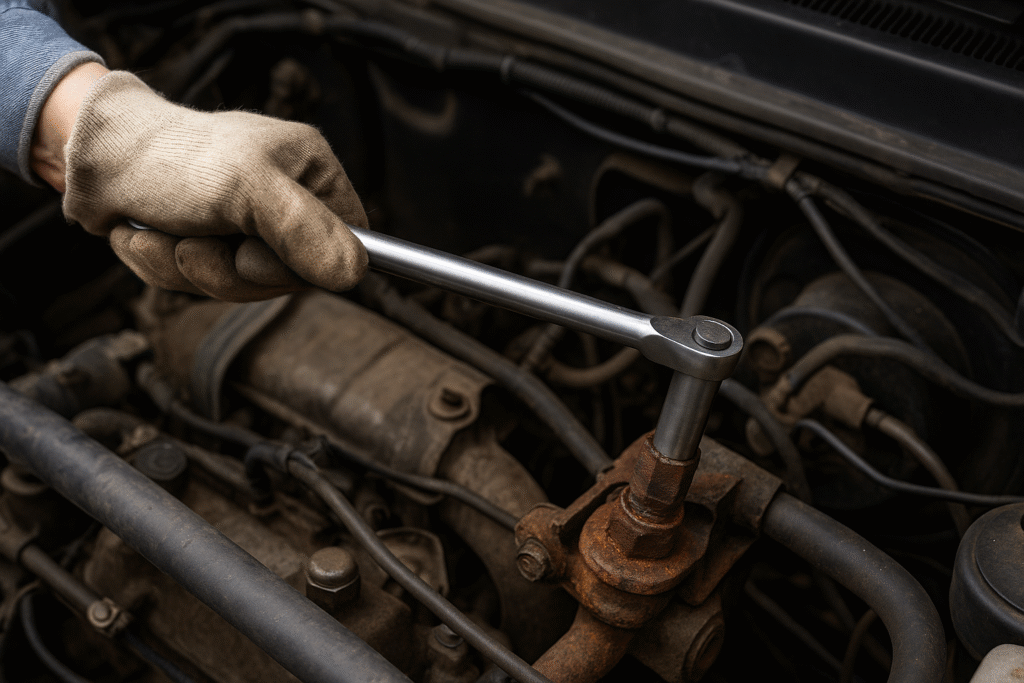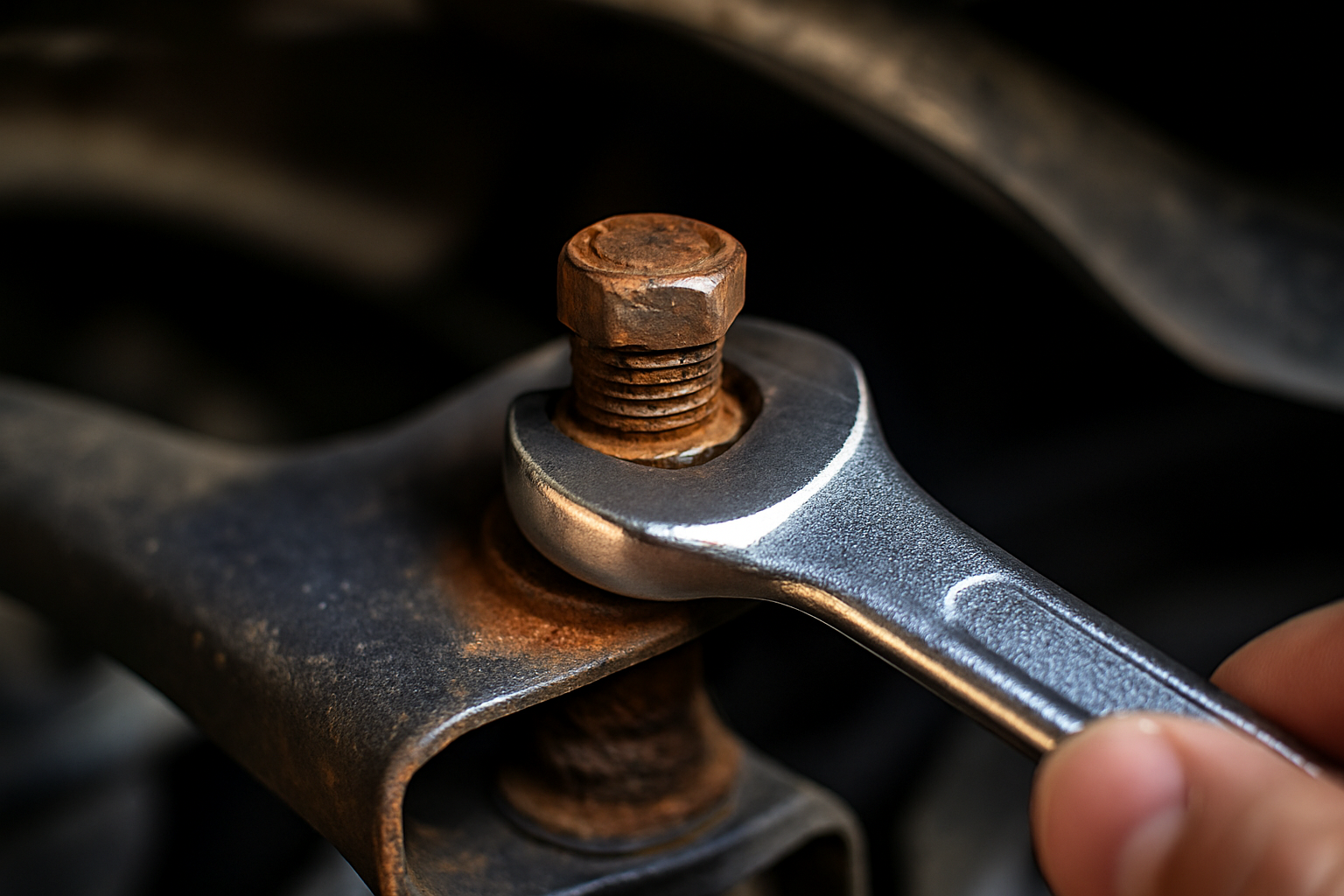Introduction
Anyone who has worked on a car, piece of machinery, or even a simple DIY home project has likely faced the frustrating problem of a seized fastener. Knowing how to get off a stuck bolt is an essential skill for both professionals and casual DIYers. Bolts can become stuck for a variety of reasons—rust, corrosion, cross-threading, or simply being tightened too much during previous repairs. When this happens, it’s not just an inconvenience. A stuck bolt can delay your project, cause damage to tools or surrounding parts, and even lead to injuries if not handled properly. Learning the right methods ensures you save time and avoid unnecessary stress.
The good news is that there are multiple proven ways to get off a stuck bolt, and most require only simple tools you may already have in your garage. From applying penetrating oil to using the right size wrench or socket, the process is all about patience and technique rather than brute force. Rushing into the problem with excessive strength often makes it worse, as bolts can snap off or strip, leaving you with an even more challenging situation. By approaching the problem methodically, you can free the bolt without causing additional damage.
Another reason to learn how to get off a stuck bolt is cost efficiency. Mechanics often charge extra for jobs that involve seized fasteners because of the added labor and risk. If you know how to handle the situation yourself, you can save money and feel more confident handling future repairs. This applies whether you’re fixing automotive parts, household furniture, or heavy-duty equipment. Mastering these skills adds to your self-reliance and makes you a more capable problem-solver in day-to-day life.
In this guide, we’ll cover everything you need to know: why it’s important to deal with stuck bolts correctly, the most common mistakes people make, and a clear step-by-step process to free them safely. By the end, you’ll have practical methods to get off a stuck bolt efficiently, along with tips to prevent bolts from seizing in the future. With the right approach, even the most stubborn bolt can be removed successfully.
Why Getting Off a Stuck Bolt Matters
At first glance, struggling to get off a stuck bolt might seem like just another frustrating inconvenience, but the reality is that it can have serious consequences if not handled properly. Bolts are designed to secure parts tightly, and when they seize up, they compromise the ability to repair or maintain critical systems. In automotive applications, for example, a stuck bolt might prevent you from replacing brake components, changing a water pump, or accessing suspension parts. Delays in addressing these repairs can lead to safety risks, unnecessary downtime, and even higher repair bills when small problems go unresolved.
Another reason it matters to get off a stuck bolt is the financial impact. Mechanics often charge extra labor fees for dealing with seized fasteners, since they require more time, specialized tools, and careful handling. For DIY enthusiasts, failing to remove a bolt correctly can mean broken parts, stripped threads, or snapped bolts that require costly professional intervention. In some cases, damage caused by forcing a bolt can result in the need for an entirely new component, multiplying costs that could have been avoided with the right technique.
Stuck bolts are also a common source of project delays. Whether you’re working on a home improvement task, machinery maintenance, or automotive repair, hitting a roadblock with a single seized bolt can halt progress altogether. Knowing how to get off a stuck bolt quickly and safely ensures that your project stays on track. Instead of wasting hours wrestling with a single fastener, you can move forward confidently, saving both time and energy.
Beyond cost and convenience, there is also the issue of safety. Applying excessive force in an attempt to loosen a bolt can cause tools to slip, leading to injuries such as cuts, bruises, or even broken bones. The smarter approach is to use proven techniques like penetrating oils, correct tool leverage, or heat application. By learning these safe methods, you reduce your risk of accidents and ensure that the repair is completed successfully. This is why understanding how to get off a stuck bolt matters so much—not just for your project, but for your wallet, your time, and your safety.
Common Mistakes People Make When Trying to Get Off a Stuck Bolt
When attempting to get off a stuck bolt, many people rely on brute force instead of proper technique. This is one of the most common mistakes and often leads to broken or stripped bolts. Applying too much pressure with the wrong tool can snap the head off entirely, leaving part of the bolt embedded in the material. Once this happens, removal becomes significantly more complicated, often requiring drilling or professional intervention. The best approach is always to start with patience and the right method, not overwhelming force.
Another frequent mistake is using the wrong size wrench or socket. A bolt that is already seized requires maximum grip, and using a tool that is even slightly loose will round off the bolt’s edges. Once stripped, it becomes much harder to get off a stuck bolt, as the tool has nothing to grip. Always ensure you’re using a perfectly fitting wrench or socket, ideally a six-point design for maximum contact. Improvising with pliers or adjustable wrenches often does more harm than good in these situations.
People also make the mistake of ignoring lubrication. Attempting to twist a dry, rusted bolt without penetrating oil is a recipe for frustration. Penetrating oils are designed to seep into the threads and break down rust, making it much easier to free the bolt. Skipping this step often results in unnecessary struggle, damage, and wasted time. Allowing oil to soak in for even a few minutes can make a dramatic difference when trying to get off a stuck bolt.
Finally, rushing the process is a mistake that undermines even good technique. People often give penetrating oil only a few seconds to work or attempt to heat the bolt unevenly with makeshift tools. Patience is key in these situations. Letting oil soak in, applying steady rather than jerky force, and using heat properly all contribute to successful removal. By avoiding these common errors—brute force, wrong tools, lack of lubrication, and impatience—you dramatically increase your chances of being able to get off a stuck bolt without causing further complications.
Step-by-Step Guide: How to Get Off a Stuck Bolt
Step 1: Prepare and Apply Penetrating Oil
The first step when you need to get off a stuck bolt is to prepare the area and use penetrating oil to loosen the rust or debris that’s binding it. Start by cleaning the area around the bolt with a wire brush or rag to remove dirt, grease, and surface rust. This ensures the oil can penetrate deeply into the threads instead of being blocked by debris. Once the area is clear, generously spray or apply a high-quality penetrating oil directly onto the bolt and the surrounding joint. Popular choices include WD-40 Specialist, PB Blaster, or Liquid Wrench, all of which are formulated specifically for freeing stuck fasteners.
After applying the oil, allow time for it to work. Many people make the mistake of spraying once and immediately reaching for a wrench, but penetrating oil requires at least 10 to 15 minutes to seep in. In more severe cases, letting it sit for several hours or even overnight provides the best results. During this waiting period, you can lightly tap the bolt with a hammer to help the oil work deeper into the threads. The vibrations break apart rust and corrosion, creating small pathways for the oil to penetrate more effectively.
Safety is also important during this step. Ensure proper ventilation when working in enclosed spaces, as penetrating oils contain strong chemicals. Wear gloves to protect your hands, and safety glasses in case of splashes. Taking these precautions helps you focus on the task without unnecessary risks. Once the oil has had time to soak, wipe away any excess to avoid making tools slippery. At this stage, the bolt should already feel slightly looser and ready for further techniques.
This preparation step may feel slow, but it is one of the most effective ways to get off a stuck bolt without damaging it. By allowing the oil to do its job, you reduce the amount of force needed later, lowering the risk of breaking the bolt or stripping the threads. In many cases, simply cleaning, lubricating, and waiting is enough to free the bolt entirely, saving you from more advanced methods.
Step 2: Use Proper Tools and Techniques
Once penetrating oil has been given time to work, the next step to get off a stuck bolt is using the correct tools and applying smart techniques. Choosing the right wrench or socket is critical. Always use a six-point socket rather than a twelve-point, as the six-point design provides better contact and reduces the chance of rounding off the bolt head. Ensure the socket fits snugly—any looseness increases the risk of slipping. Attach the socket to a sturdy ratchet or breaker bar for added leverage. A breaker bar in particular is useful for stubborn bolts because it provides greater torque without requiring sudden bursts of force.
If the bolt still resists, try using steady, controlled pressure instead of quick, jerky motions. Applying slow and even force allows the threads to break free gradually. In some cases, tightening the bolt slightly before loosening can also help break the rust bond. This small movement can create enough space for the threads to move, making it easier to get off a stuck bolt. Another technique is rocking the bolt back and forth—tightening and loosening incrementally—to slowly ease it free without stripping the head.
For additional grip, consider using specialized tools like bolt extractors or impact wrenches. Bolt extractors are designed to bite into rounded or seized bolts, providing a firm grip that standard sockets can’t achieve. Impact wrenches, on the other hand, deliver rapid bursts of torque that can shock a bolt free without constant heavy pressure. If you don’t own these tools, many auto parts stores offer rental options, making them accessible for occasional DIY jobs.
Leverage also plays a major role. Extending the handle of your wrench or breaker bar with a pipe—often called a “cheater bar”—provides more torque with less effort. However, this should be done carefully, as too much torque can snap the bolt. Always combine leverage with lubrication and patience for best results. By using properly sized sockets, controlled pressure, and advanced tools when necessary, you’ll greatly improve your chances to get off a stuck bolt safely and effectively.

Step 3: Apply Heat or Advanced Methods
If lubrication and proper tools still aren’t enough to get off a stuck bolt, the next step is to use heat or other advanced methods. Heat works by expanding the metal, breaking the rust bond between the bolt and its threads. This is often the final push needed to loosen even the most stubborn bolts. A propane torch is the most common tool for this job. Direct the flame onto the bolt for 30 to 60 seconds, focusing on the metal around the threads rather than just the bolt head. Once heated, allow it to cool slightly, then try loosening it with your wrench or breaker bar. The thermal expansion and contraction often crack the rust seal, making removal possible.
If using a torch, safety precautions are crucial. Keep a fire extinguisher nearby, avoid heating bolts near fuel lines or flammable materials, and wear protective gloves and goggles. When working on automotive parts, be especially careful around rubber seals, wiring, or painted surfaces, as these can be damaged by excessive heat. Heat is effective, but it must be used responsibly to avoid creating more problems than it solves. This careful balance ensures you can get off a stuck bolt without putting yourself or your equipment at risk.
In some cases, mechanical shock is another advanced technique. Striking the bolt head firmly with a hammer can help break the corrosion bond. This method works especially well in combination with penetrating oil, as the vibrations help the oil seep deeper into the threads. For heavily corroded bolts, an impact driver can also be used to deliver rotational force while striking downward, reducing the risk of stripping the head. These shock-based methods are ideal when you need to get off a stuck bolt that refuses to move with leverage alone.
As a final option, bolt extractors or drilling may be necessary. Extractors bite into damaged or rounded bolts, allowing you to twist them out when regular sockets can’t grip. If the bolt has snapped or is beyond saving, drilling it out and re-threading the hole is the ultimate solution. While this is more advanced and may require professional tools, it guarantees removal when all else fails. By combining heat, shock, and extraction methods, you’ll always have a strategy to get off a stuck bolt, no matter how severe the corrosion or damage.
FAQs About Getting Off a Stuck Bolt
Can all stuck bolts be removed without professional help?
Many people wonder if they can get off a stuck bolt without hiring a mechanic or professional. In most cases, the answer is yes. With penetrating oil, proper tools, and patience, most seized bolts can be freed at home. However, extremely rusted or snapped bolts may require advanced equipment such as drills, extractors, or welding tools that the average DIYer may not have. While most bolts can be removed with persistence, there are rare situations where professional help is the most practical option to avoid damaging surrounding parts or wasting valuable time.
What is the best penetrating oil for loosening bolts?
Choosing the right penetrating oil can make it much easier to get off a stuck bolt. Popular brands include PB Blaster, Liquid Wrench, and WD-40 Specialist, all designed to break down rust and lubricate threads. These oils work by seeping into tight spaces between the bolt and threads, reducing friction and corrosion. While WD-40 is a household staple, specialized penetrating oils often perform better for tough jobs. For maximum effectiveness, apply generously and allow time—sometimes hours—for the oil to work before attempting removal.
Is it safe to use heat on a stuck bolt?
Using heat is one of the most effective ways to get off a stuck bolt, but safety precautions are essential. Applying a propane torch or heat gun expands the metal, breaking the rust bond. However, heat should never be used near fuel lines, plastic parts, wiring, or flammable materials. Always keep a fire extinguisher nearby and wear gloves and eye protection. When used responsibly, heat is safe and highly effective, but carelessness can cause damage to your car or workspace.
What if the bolt head becomes stripped?
A stripped bolt head is a common frustration when trying to get off a stuck bolt. If this happens, specialized tools like bolt extractors are designed to grip rounded edges. Alternatively, locking pliers can sometimes provide enough grip to turn the bolt. Impact drivers and extractor sockets are also effective solutions. Avoid continuing with regular wrenches once stripping occurs, as it only makes the problem worse. With the right extractor tools, even a stripped bolt can usually be removed successfully.
How can I prevent bolts from getting stuck in the future?
Prevention is the easiest way to avoid having to get off a stuck bolt in the future. Always apply a small amount of anti-seize compound to bolts when reinstalling them, especially in areas exposed to moisture, salt, or heat. Regularly maintaining your vehicle or machinery also reduces the buildup of rust and corrosion. Using the correct torque when tightening bolts ensures they are secure without being overtightened. With these precautions, you’ll minimize the chance of bolts seizing and make future repairs much smoother.
Conclusion
Learning how to get off a stuck bolt is one of the most practical skills any DIYer, car owner, or mechanic can master. Stuck bolts are a common obstacle in projects ranging from auto repairs to household fixes, and without the right approach, they can quickly derail progress. Fortunately, with patience, proper preparation, and the correct techniques, most bolts can be freed without resorting to expensive professional services. From using penetrating oil to applying controlled torque and even using heat, the strategies covered in this guide provide you with a reliable toolkit to handle seized fasteners confidently.
The key is to avoid rushing. Brute force often leads to stripped or broken bolts, which only make the job harder. Instead, approach the task step by step—clean the area, lubricate the threads, use the correct size tools, and escalate to advanced methods like heat or extractors if needed. By taking a systematic approach, you can get off a stuck bolt effectively while preserving both your tools and the surrounding parts. These techniques save you time, money, and frustration, while also improving your overall repair skills.
Beyond the immediate fix, this knowledge also helps with prevention. Applying anti-seize compounds, storing equipment properly, and maintaining vehicles regularly are small steps that go a long way toward avoiding stuck bolts in the future. Prevention reduces the likelihood of running into the same problem again, making all of your projects smoother and more enjoyable. Once you know how to get off a stuck bolt, you’re better prepared for whatever challenges your next project brings.
📌 Read Similar Topics
- Repressuring a Boiler
- Fix Moen Shower Valve
- Door Latch Not Fully Retracting
- Dead Pixel Test
- Marble Scratch Repair
For more in-depth repair guidance, check these authoritative resources:
Popular Mechanics on Removing Stuck Bolts,
Wikipedia: Bolt (Fastener), and
Family Handyman Guide to Stuck Bolt Removal.
In conclusion, with the right knowledge and preparation, even the most stubborn fasteners can be removed. By practicing these methods, you’ll never feel helpless when faced with a seized fastener again. Instead, you’ll know exactly how to get off a stuck bolt safely, efficiently, and with confidence.
Share this:
- Click to share on Facebook (Opens in new window) Facebook
- Click to share on X (Opens in new window) X
- Click to share on LinkedIn (Opens in new window) LinkedIn
- Click to share on Reddit (Opens in new window) Reddit
- Click to share on X (Opens in new window) X
- Click to share on Threads (Opens in new window) Threads
- Click to share on WhatsApp (Opens in new window) WhatsApp





Pingback: How To Remove A Screw Without A Screwdriver Smartly And Easily